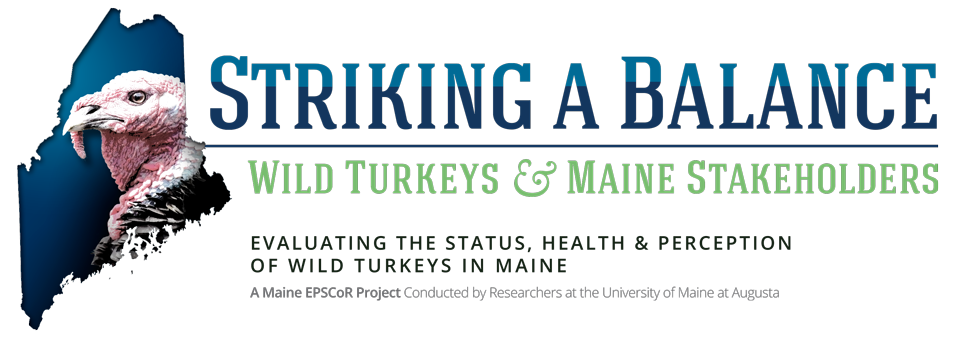Problem
Numerous studies have examined population structure of wild turkeys across parts of their range (Leberg 1991, Boone and Rhodes 1996, Krakauer 2005, Latch and Rhodes 2005, Mock et al. 2002, 2004, & 2009), however the current genetic structure of the Maine turkey population is unclear given the two separate reintroductions in the 1970’s and 1980’s, on-going in-state trap & transfer activities, and rapid population growth over the past four decades. The initial number of wild turkeys giving rise to the current Maine population is small and may represent a genetic founder effect (Leberg 1991, Latch and Rhodes 2005). In addition, the extent of genetic introgression from pen-raised domesticated breeds is also unknown among Maine wild turkeys (Latch et al. 2006, Kamara et al. 2007). In 1991, Maine introduced rule-making efforts to deal with unintended consequences of pen-raised turkey releases. The only current population genetic information on Maine wild turkeys is a limited database at the University of Maine Molecular Forensic Laboratory (Dr. Irv Kornfield, personal communication) for assisting the Maine Warden Service with poaching cases involving turkeys. A vast number of species-specific genetic markers are readily available for examining wild turkeys (Huang et al. 1999, Latch et al. 2002, Burt et al. 2003, Guan et al. 2008, Kamara et al. 2007, Latch and Rhodes 2005, Szalanski et al 2000).
Research Actions
Tissue samples and/or blood samples are collected from harvested turkeys at tagging stations during the fall and spring hunts. Additional samples are collected from turkeys captured by MDIFW biologists at agricultural sites and from birds destined for management-based relocation or nuisance-based termination. DNA is isolated from these samples and analyzed for population genetic structure. Various genetic markers including nuclear microsatellite (i.e. Short Tandem Repeat) loci and the mitochondrial control-region are evaluated via PCR and subsequent fragment and sequence analysis. When possible, preserved historic Maine wild turkey samples (i.e. saved feathers or mounts), non-native wild turkeys, known domestic-strains, and putative wild-domestic hybrid samples are used for comparison to extant Maine wild turkeys. All results will be compiled with the genetic database at the University of Maine Molecular Forensic Laboratory (UMMFL) to facilitate analysis of poaching case evidence for the Maine Warden Service.
As of July 2013, over 180 tissue and blood samples have been collected and DNA successfully extracted from domestic and wild turkeys and an additional 170 tissue samples have been collected awaiting DNA extraction. 124 samples have been successfully sequenced at the mitochondrial control-region and 50 samples have been successfully amplified currently awaiting sequencing. Results thus far show that “domestic” mitochondrial haplotypes are, in large part, differentiated from the “wild” haplotypes, however a few putative “wild” birds do, in fact, show the predominant “domestic” signature suggesting that there may have been some genetic introgression of domestic strain(s) into the “wild” Maine population. Additional analyses are currently underway to better understand this observation. This includes the examination of putative “wild” samples from 1990’s and more recent putative “wild-domestic hybrids”. Multiplex PCR conditions are currently being optimized for 8 nuclear microsatellite (i.e. Short Tandem Repeat) loci specific to turkey species within the genus Meleagris. At this point, no clear population structuring has been observed among wild turkeys. This is not unexpected and is consistent with historic trap/transfer activities throughout the state which would tend to disrupt any local wild population structuring via human intervention.
Citations
Boone and Rhodes (1996) Genetic Structure among Subpopulations of the Eastern Wild Turkey (Meleagris gallopavosilvestris), American Midland Naturalist, 135/1: 168-171.
Burt et al. (2003) Preliminary linkage map of the Turkey (Meleagris gallopavo) based on microsatellite markers. Animal Genetics. 34: 399-409.
Guan et al. (2008) The mitochondrial genome sequence and molecular phylogeny of the turkey, Meleagris gallopavo. Animal Genetics. 40:134-141.
Huang et al. (1999) Development and characterization of genetic mapping resources for the turkey (Meleagris gallopavo). Journal of Heredity. 90(1): 240-242.
Krakauer, A. (2005) Kin selection and cooperative courtship in wild turkeys. Nature. 434: 69-72.
Latch et al. (2002) Isolation and characterization of microsatellite loci in wild and domestic turkeys (Meleagris gallopavo). Molecular Ecology Notes, 2:176-178.
Latch et al. (2006) Assessing Hybridization in Wildlife Populations Using Molecular Markers: A Case Study in Wild Turkeys. Journal of Wildlife Management. 70(2): 485-492.
Latch and Rhodes (2005) The effects of gene flow and population isolation on the genetic structure of reintroduced wild turkey populations: Are genetic signatures of source populations retained? Conservation Genetics. 6:981-997.
Leberg, P. (1991) Influence of Fragmentation and Bottlenecks on Genetic Divergence of Wild Turkey Populations, Conservation Biology, 5(4): 522-530.
Mock et al. (2002) Genetic variation across the historical range of the wild turkey (Meleagris gallopavo). Molecular Ecology, 11: 643-657.
Mock et al. (2004) Assessing losses of genetic diversity due to translocation: long-term case histories in Merriam’s turkey (Meleagris gallopavo merriami), Conservation Genetics 5: 631-645.
Mock et al. (2009) Verifying the origins of a reintroduced population of Gould’s wild turkey. Journal of Wildlife Management. 65(4):871-879.
Szalanski et al. (2000) Mitochondrial-DNA variation within and among wild turkey (Meleagris gallopavo) subspecies. Transactions of the Nebraska Academy of Sciences. 26:47-53.
